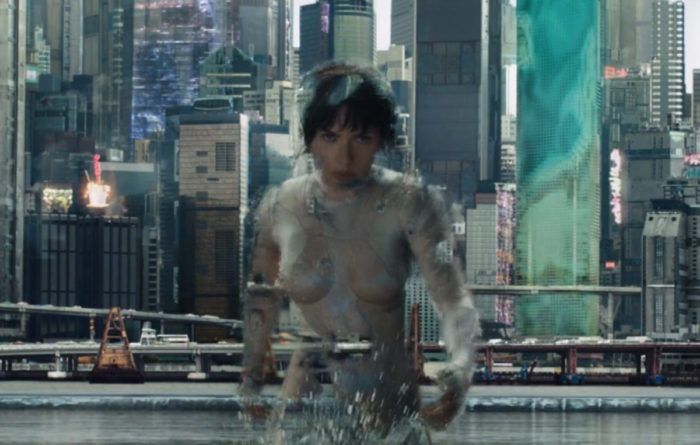Published in the Nikkei Asian Review 13/3/2017
Here’s a slice of British reality. It’s a rainy night and I’m sitting in a cinema in George Street, Oxford. I’m watching Ghost in the Shell, a Hollywood live-action remake of a Japanese anime film.
A stone’s throw away is the site of a recently defunct nightclub called Roppongi. This establishment billed itself as “a unique playground for Oxford’s elite” and featured exotic cocktails such as Electric Kabuki and Oh, My Godzilla, some of which contained trace quantities of real sake.
Now it has gone forever, although nearby Japanese-style restaurants continue to ply their trade, ranging from noodle-pushers Wagamama to Yo! Sushi, with its revolving conveyor belt and video-clips of Shibuya crossing.
Authentic? No more so than the Japanese version of curry rice or, indeed, Scarlett Johansson playing Major Motoko Kusanagi, the cyborg heroine of Ghost in the Shell. The film kicked off a brouhaha in the U.S. when Asian-American activists objected to the Asian role of Kusanagi being played by a white star. That, apparently, constitutes an act of cultural appropriation known as “white-washing,” a serious offence in the grievance-charged world of American identity politics.
In Japan, which has made cultural appropriation a national strategy for the last 150 years, such thinking makes no sense at all. Mamoru Oshii, famed director of the 1995 anime version of Ghost in the Shell, praised Johansson as “the best choice possible” for the role. As he went on to say, films have always taken a creative approach to casting with, for example, Omar Sharif, an Arab, playing Doctor Zhivago, a Russian.
Art can transcend gender as well as ethnicity. I recently saw the great British actress Glenda Jackson play King Lear on stage in London. She was totally convincing.
Geographical mash-up
The world of Japanese anime and manga has always been one of cultural and ethnic indeterminacy, in which Japanese-speaking characters have Westernized features and implausible physiques.
The Ghost in the Shell film takes place in a generically “Asian” metropolis. The futuristic city contains yakuza-run bars and geisha-assassins. Yet the cityscape itself is clearly a digitally enhanced version of Hong Kong, with its spectacular harbor and teeming alleys. The chief of Public Security, played by eccentric celebrity “Beat” Takeshi Kitano, is the only character to speak in Japanese, which is helpfully subtitled in English.
The decision to “Sinocize” the backdrop may relate to the fact that two Chinese companies financed the production. Even so, the melding of geographical identities is squarely in the “cyber-punk” science-fiction tradition.
Ridley Scott’s hugely influential film Blade Runner, released in 1982, was set in a “Japan-ized” vision of 2019 Los Angeles, complete with sushi-masters, noodle bars and gigantic video-screen geisha. Likewise, William Gibson’s ground-breaking 1984 novel “Neuromancer,” which foresaw today’s networked world of hackers and giant online companies, takes place in a hyper-real “Chiba City”.
It is not just the visual texture that Ghost in the Shell owes to cyber-punk SF. The theme is the same too. What is the difference between the implanted memories of a replicant and genuine human experience? Could what we think of as everyday reality be a fiction? This was the metaphysical conundrum that obsessed American writer Philip K. Dick, whose novel Do Androids Dream of Electric Sheep? was the basis for Blade Runner.
Masamune Shirow, author of the original manga of Ghost in the Shell, must have been influenced by Dick’s vision as well as by Arthur Koestler, whose book The Ghost in the Machine provides the title. As Shirow told manga expert Frederik L. Schodt, “creating humanoid robots involves seeing how much you can replicate human structure, which in turn involves understanding what it means to be human.”
Judging by the Johansson film, the future hasn’t changed much since the early 1980s. That may be because the cyberpunks were unusually far-sighted. Today the approach of “the singularity,” when machine intelligence will surpass the capability of humans, is no longer science fiction, but a business topic discussed by Silicon Valley executives.
Meanwhile, bestselling historian Yuval Noah Harari declares that the biotechnological revolution signals the end of homo sapiens. One day the controversy may not be about whether the role of an Asian cyborg should be played by an American, but whether it should be played by a cyborg
Heavy thoughts to ponder, as I sit before the Yo! Sushi conveyor belt with its freight of spicy tuna roll, fried rice and apple gyoza dumplings. It wouldn’t pass muster in Tokyo, but is just right for a rainy night in Oxford. The ghost of sushi lives on in the British shell.

The generic Asian metropolis that takes the place of the fictional Japanese city of Nihama, capital of Nihama Prefecture, in the original manga of “Ghost in the Shell”.

